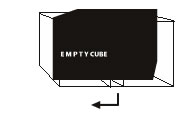NUNO NUNES FERREIRA
JANUARY, 23, 2015

CONTACTS
www.nunonunes-ferreira.com
EXHIBITION INFORMATION
circa diem
7 dossier
7 File Boxes
1866 printed sheets (project)
96 printed sheets (bibliography)
3 tv monitors
3 Hard drives
7 tables in iron and MDF lacquered in black
variable dimensions
2014/2015
A paradox, for a day
The work of Nuno Nunes Ferreira consistently features an archival practice that acts as a driving force within his working process. In many of his pieces that procedure is immediately apparent, while in others it takes the form of an element that is organised and concatenated in accordance with a different sort of parametres demanded by the work in question, and is thus not limited by a more canonical archival practice, which in his work also comprises a gleaning activity that questions the notion of an archive as a system that does nothing but receive data. If we wish, we may describe that activity as nomadic, in the sense that the search is not always predetermined by a concrete aim, and neither can be reduced to a mere accumulation of curiosities.
Nunes Ferreira develops a close relationship with history as a means to reorganise human knowledge in a wide variety of areas, such as politics, folk tales and the stories and histories images sometimes tell, among others that challenge our memory, our knowledge or the fear of war and authoritarian coercion that underlies the abovementioned political relationship.
On the other hand, the artist also shows great determination to broaden the field of his researches, as he creates visual schemes in which we seemingly become lost, while aware that time and its metrics are defining an impudent and often transgressive gaze that does not limit itself to dealing with a variety of subjects or reactivating the meaning of historic records that are familiar to us, but to which we accord the status of memory objects that reside, and often abide, in the wide mental space we normally call 'the past'.
Such was the context within which 'Circa Diem' was conceived and executed for the short-lived event that is EMPTY CUBE. The work is displayed in two different forms, one of which can be found at the ephemeral cubic space and the other at the exhibition room of Appleton Square, the gallery that hosts the project. The first form is dynamic; the second is inert, and only becomes active through its handling. The first instance is a digital device that takes the form of a bibliographic timepiece, which indicates real time by displaying its measuring units, written and inscribed on a variety of documents that detail each second, minute and hour, and finally one full year, displayed as only two pages. The second form consists of the documents that were digitalised for use in the first; through it, we are confronted by the physical dimension of that year, divided into file folders that are chronologically organised into one-second units. All this process is based on Nuno Nunes Ferreira's study of the concept of circadian (from the Latin circa diem, which means 'roughly one day') cycle. In the human species, the circadian rhythm or cycle defines behaviours that can be associated with what is normally called the biological clock, a part of our brain's central structure (more precisely the hypothalamus) that acts as a regulating system. However, this phenomenon is also echoed in animal migrations and in plant growth, within a temporal cycle that is punctuated by the presence of sunlight and its absence during the night: a metaphor of the natural (and sometimes contradictory) order that defines itself between wakefulness and sleep, between the presence of the gaze and its resistance to fallacy and the exhaustion of the body that yields to the passing of time.
Nuno Nunes Ferreira employs this model exponentially, by amassing a bibliographic archive that includes, for instance, a page from a British timetable that displays a moment of the year: 'twelve P.M.', and also, on the last page of the paper archive, the words 'one second'. The latter will be in fact the first page of a temporal arc that covers one year and is continuously dissected until the last second of that same year, whose reference in time is the exact day of the project's presentation at EMPTY CUBE: January 23, 2015. The work's metrics condenses temporality, juxtaposing it to a textual palimpsest that writes the time this project displays before us, in an apparently condensed form that paradoxically runs in real time or can be consulted page by page, forcing us to bear the weight of the matter we run through in the possible, but also real, time our corporeality allows.
João Silvério
January 2015






